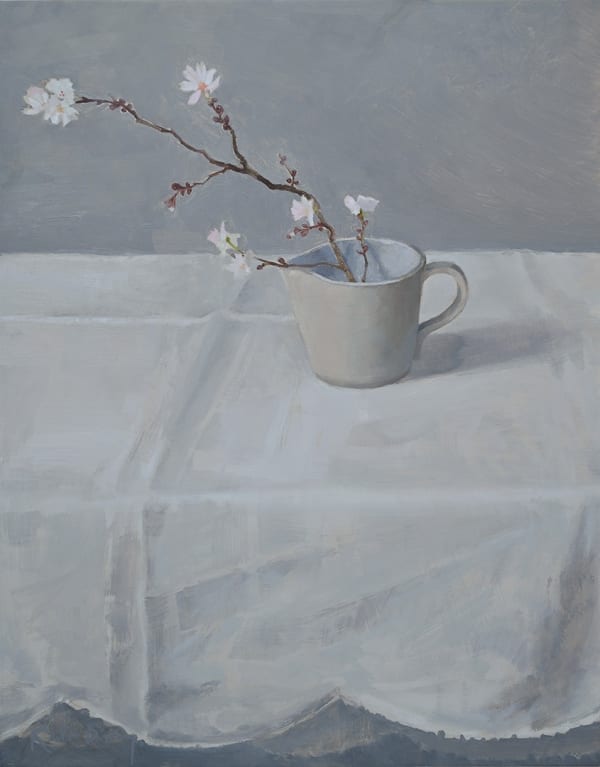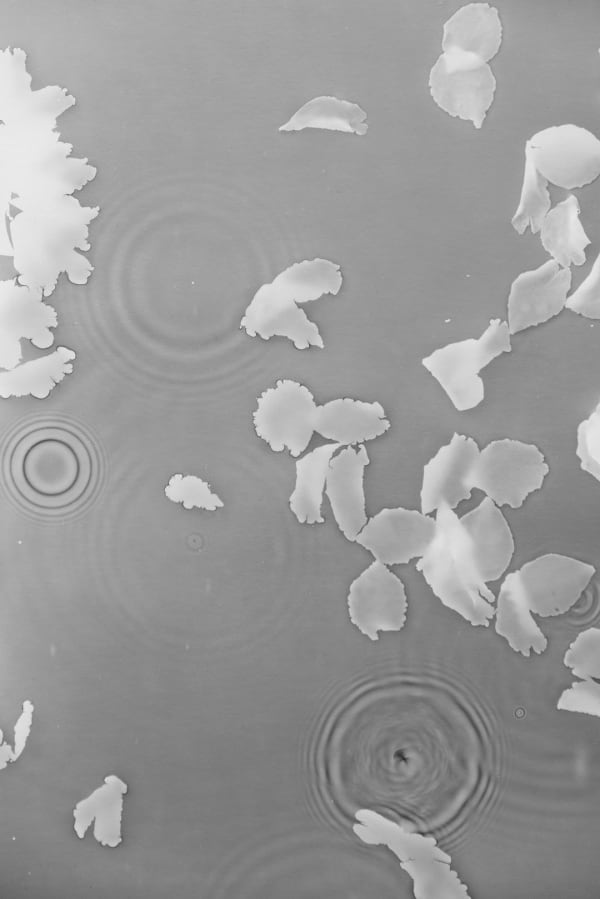Kate Beaugié British, b. 1975
Kate Beaugié studied sculpture at Glasgow School of Art in the late 90s. There she began her life long investigation into the way we are exposed to light, according to our position on Earth and its journey around the sun. Working with light (and its absence) as a medium, she adopted the term light sculptor for how it described her manipulation of light and dark through a variety of media and their relation to the surrounding space. In this process, she came to regard photograms as 2D sculptures, for how they record the shadow or physical memory of three-dimensionality, and suggest space. This research also extends to paintings. By focusing specifically on the light and shadows in the portrayed scene, Beaugié invites the viewer to examine and to experience to some degree, the three-dimensionality created in the painting.
Kate Beaugié's work is an investigation into the sublime experience of natural phenomena. She works with elemental forces: light and the resulting shadow, water, fire and sound waves, which are employed directly into the making of her work.
Influences include Japanese and Chinese aesthetics and thought, especially Zen and Taoist philosophy. It is also likely that spending her formative years in Glasgow Art School's Mackintosh Building introduced the square motif into her visual lexicon. Sculpturally inclined, Beaugié extended this into the cube for how it acts as a receptacle and reflector of light. Like light and dark, the contrast between the hard-edged geometric and the flowing, curved forms found in nature has been a continuing preoccupation in her artistic exploration; which can be describes as an investigation into finding balance between opposing agencies.
Frequently, she introduces sound and music into her work, often in live site-specific performances; Music & Light Symbiotic Events. These performative works are highly collaborative and allow the artist to explore new aspects of an expanded practice - conducting and curating - with an exciting line up of internationally renowned classical musicians. Conceiving of light and water installations, in response to their physical presence and music, she creates a multi-sensory, fully immersive experience.
For example, in APPLIED PURE at the MI, Beaugié introduced the harpsichordist Medea Bindewald playing JS Bach (as well as other composers), to the public and to the Mathematicians of the University of Oxford, whilst they watched live diffracted light off water patterns projected above her. In 2021, in BEETHOVEN ON THE BEACH, Beaugié placed the Sacconi Quartet directly onto the beach, under the iconic arches of Folkestone's Sunny Sands in Folkestone and crowds listened to them play Beethoven's op.131 whilst the tide rose and the turn of the earth was recorded by a simple line drawn by the artist against the advancing shadows made by the arch.
Beaugié's work is held in the permanent public collections of VAULT100 at The Ned in London curated by Kate Bryan, at The Mathematical Institute of University of Oxford curated by Balázs Szendroi, as well as in the Hampshire County Council's Art collection.
She has exhibited her work nationally in numerous solo and group shows and has engaged in a series of artist residencies.
Kate Beaugié has also achieved Arts Council funding twice to develop her practice and is presently developing two publications of her artwork.
-
 Kate BeaugiéMother's Milk | Winter Flowering Blossom in Jug, 2024Oil on gessoed board35.7 x 28 cm
Kate BeaugiéMother's Milk | Winter Flowering Blossom in Jug, 2024Oil on gessoed board35.7 x 28 cm
14 1/16 x 11 inView more details -
 Kate BeaugiéInside Jarman's Womb, 2022Oil on gessoed board25.5 x 25.5 cm
Kate BeaugiéInside Jarman's Womb, 2022Oil on gessoed board25.5 x 25.5 cm
10 1/16 x 10 1/16 inView more details -
 Kate BeaugiéString of Hearts | Absence, 2019Oil on board25 x 21 cm
Kate BeaugiéString of Hearts | Absence, 2019Oil on board25 x 21 cm
9 13/16 x 8 1/4 inView more details -
 Kate BeaugiéSwan Song, 2019digitally inverted photogram, Giclée Print on Hahnemühle photo rag, mounted on board
Kate BeaugiéSwan Song, 2019digitally inverted photogram, Giclée Print on Hahnemühle photo rag, mounted on board
Unique40.9 x 102 cm
16 1/8 x 40 3/16 inView more details -
 Kate BeaugiéNature Morte Diptych, 2023Photogrameach 43 x 30 cm
Kate BeaugiéNature Morte Diptych, 2023Photogrameach 43 x 30 cm
16 15/16 x 11 13/16 inView more details -
 Kate BeaugiéNew Shadow / Early Light, 2023Oil on gesso panel30 x 15 cm
Kate BeaugiéNew Shadow / Early Light, 2023Oil on gesso panel30 x 15 cm
11 13/16 x 5 15/16 inView more details -
 Kate BeaugiéDeep water, 2020oil on canvas96.5 x 60 cm
Kate BeaugiéDeep water, 2020oil on canvas96.5 x 60 cm
38 x 23 5/8 inView more detailsKate Beaugié, Deep water, 2020£ 900.00 -
 Kate BeaugiéBlossom and Raindrops 1 , 2019Digitally enlarged photogram, limited edition Giclée print, Hahnemühle photo rag, mounted onto Diasec and then mounted under acrylic73.5 x 50 cm
Kate BeaugiéBlossom and Raindrops 1 , 2019Digitally enlarged photogram, limited edition Giclée print, Hahnemühle photo rag, mounted onto Diasec and then mounted under acrylic73.5 x 50 cm
28 15/16 x 19 11/16 inEdition of 3View more details -
 Kate BeaugiéDrop God, 2019Digitally enlarged photogram, limited edition Giclée print, Hahnemühle photo rag, mounted onto Diasec and then mounted under acrylic92.3 x 92.3 cm
Kate BeaugiéDrop God, 2019Digitally enlarged photogram, limited edition Giclée print, Hahnemühle photo rag, mounted onto Diasec and then mounted under acrylic92.3 x 92.3 cm
36 5/16 x 36 5/16 inEdition of 6View more detailsKate Beaugié, Drop God, 2019£ 1,200.00 -
 Kate BeaugiéFeathers Floating, 2019Digitally enlarged photogram, limited edition Giclée print, Hahnemühle photo rag, mounted onto Diasec and then mounted under acrylic50 x 35.4 cm
Kate BeaugiéFeathers Floating, 2019Digitally enlarged photogram, limited edition Giclée print, Hahnemühle photo rag, mounted onto Diasec and then mounted under acrylic50 x 35.4 cm
19 11/16 x 13 15/16 inEdition of 9View more details -
 Kate BeaugiéForget me nots in Glass of Water, 2019Digitally enlarged photogram, limited edition Giclée print, Hahnemühle photo rag, mounted onto Diasec and then mounted under acrylic50 x 36.3 cm
Kate BeaugiéForget me nots in Glass of Water, 2019Digitally enlarged photogram, limited edition Giclée print, Hahnemühle photo rag, mounted onto Diasec and then mounted under acrylic50 x 36.3 cm
19 11/16 x 14 5/16 inEdition of 6View more details -
 Kate BeaugiéHand in developer | Primal, 2019Digitally enlarged photogram, limited edition Giclée print, Hahnemühle photo rag, mounted onto Diasec and then mounted under acrylic73.5 x 59.1 cm
Kate BeaugiéHand in developer | Primal, 2019Digitally enlarged photogram, limited edition Giclée print, Hahnemühle photo rag, mounted onto Diasec and then mounted under acrylic73.5 x 59.1 cm
28 15/16 x 23 1/4 inEdition of 6View more details -
 Kate BeaugiéHand through Developer Diptych, 2019Digitally enlarged photogram, limited edition Giclée print, Hahnemühle photo rag, mounted onto Diasec and then mounted under acrylic58 x 84 x 2 cm
Kate BeaugiéHand through Developer Diptych, 2019Digitally enlarged photogram, limited edition Giclée print, Hahnemühle photo rag, mounted onto Diasec and then mounted under acrylic58 x 84 x 2 cm
22 13/16 x 33 1/16 x 13/16 inEdition of 3View more details -
 Kate BeaugiéShadow of Four Cubes | Glimpse, 2019Digitally enlarged photogram, limited edition Giclée print, Hahnemühle photo rag, mounted onto Diasec and then mounted under acrylic118.9 x 43 cm
Kate BeaugiéShadow of Four Cubes | Glimpse, 2019Digitally enlarged photogram, limited edition Giclée print, Hahnemühle photo rag, mounted onto Diasec and then mounted under acrylic118.9 x 43 cm
46 13/16 x 16 15/16 inEdition of 3View more details -
 Kate BeaugiéWashing Hands triptych, 2019Digitally enlarged photogram, limited edition Giclée print, Hahnemühle photo rag, mounted onto Diasec and then mounted under acryliceach panel 96.5 x 75.3 cm
Kate BeaugiéWashing Hands triptych, 2019Digitally enlarged photogram, limited edition Giclée print, Hahnemühle photo rag, mounted onto Diasec and then mounted under acryliceach panel 96.5 x 75.3 cm
38 x 29 5/8 in
Overall dimensions: 96.5 x 225.9 cm
38 x 88 15/16 inEdition of 3View more details -
 Kate BeaugiéWave I, 2019Giclée print on Hahnemühle Photo Rag, Diasec mounted under acrylic50.8 x 73.7 cm
Kate BeaugiéWave I, 2019Giclée print on Hahnemühle Photo Rag, Diasec mounted under acrylic50.8 x 73.7 cm
20 x 29 inEdition of 9View more detailsKate Beaugié, Wave I, 2019£ 620.00 -
 Kate BeaugiéDrops and Feather floating diptych, 2018photogram
Kate BeaugiéDrops and Feather floating diptych, 2018photogram
unique35.6 x 53.3 cm
14 x 21 inView more details -
 Kate BeaugiéBlossom and Raindrops diptych, 2018Photogrameach frame 65 x 54 cm
Kate BeaugiéBlossom and Raindrops diptych, 2018Photogrameach frame 65 x 54 cm
25 9/16 x 21 1/4 inView more details -
 Kate BeaugiéDark Tide, 2017photogram collage
Kate BeaugiéDark Tide, 2017photogram collage
unique35.6 x 53.3 cm
14 x 21 inView more details -
 Kate BeaugiéShadow of gold cube and blossom triptych, 2018photogram
Kate BeaugiéShadow of gold cube and blossom triptych, 2018photogram
unique
Mounted on aluminium, framed with UV glasseach photogram 50.8 x 40.6 cm
20 x 16 in
overall framed dimensions:
60 x 130 cm
23 5/8 x 51 3/16 inView more details -
 Kate BeaugiéStill Life | Cecilia in the bath, 2019Digitally enlarged photogram, limited edition Giclée print, Hahnemühle photo rag, mounted onto Diasec and then mounted under acrylicheight 143 cm
Kate BeaugiéStill Life | Cecilia in the bath, 2019Digitally enlarged photogram, limited edition Giclée print, Hahnemühle photo rag, mounted onto Diasec and then mounted under acrylicheight 143 cm
height 56 5/16 inEdition of 3View more details























